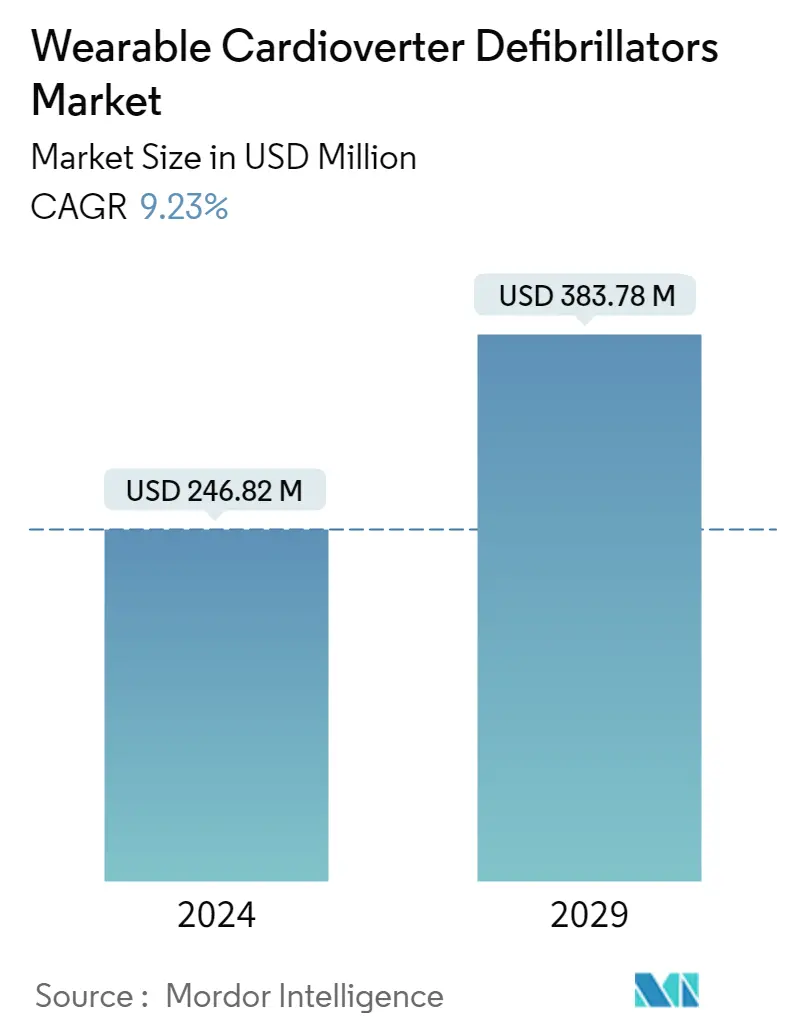Market Size of Wearable Cardioverter Defibrillators Industry

| Study Period | 2021 - 2029 |
| Market Size (2024) | USD 246.82 Million |
| Market Size (2029) | USD 383.78 Million |
| CAGR (2024 - 2029) | 9.23 % |
| Fastest Growing Market | Asia-Pacific |
| Largest Market | North America |
Major Players
*Disclaimer: Major Players sorted in no particular order |
Need a report that reflects how COVID-19 has impacted this market and its growth?
Wearable Cardioverter Defibrillators Market Analysis
The Wearable Cardioverter Defibrillators Market size is estimated at USD 246.82 million in 2024, and is expected to reach USD 383.78 million by 2029, growing at a CAGR of 9.23% during the forecast period (2024-2029).
The COVID-19 pandemic significantly impacted the growth of the wearable cardioverter defibrillator market. An article published in Nature Medicine in February 2022 observed that people with COVID-19 are more likely to have cardiovascular diseases, such as heart failure, thromboembolic disorders, dysrhythmias, ischemic and non-ischemic heart disease, pericarditis, myocarditis, and ischemic and non-ischemic heart disease. Thus, the high burden of CVD-related diseases raised the demand for wearable cardioverter defibrillator devices to monitor heart rhythm during the pandemic period as they allowed contactless communication and tracking of medical conditions by clinicians. Moreover, with released restrictions and resumed cardiac treatment and services, the studied market is expected to grow over the forecast period.
Factors such as the increasing prevalence of cardiovascular disorders, the rising geriatric population, and the ease of use of non-invasive devices are boosting the market growth. For instance, as per BHF's 2022 report, more than 7.6 million people in the United Kingdom were living with cardiovascular diseases in 2021. Hence, cardiovascular diseases and their high prevalence is expected to increase the demand for regular monitoring of heart rhythm, propelling the market growth. Also, according to the October 2022 update of the CDC, about 805,000 people in the United States have a heart attack every year. Hence, cardiovascular diseases and their high prevalence is expected to increase the demand for regular monitoring of heart rhythm, propelling the market growth.
In addition, the increasing prevalence of obesity, diabetes, hypertension, and high cholesterol among the population is contributing to market growth. According to the 2022 statistics published by UNICEF World Obesity Atlas, more than 27 million children will suffer from obesity by 2030 in India. Thus, the expected increase in the obese population may increase the risk of atrial fibrillation (AF), which reduces blood flow and leads to a heart attack. This is anticipated to propel the demand for cardioverter defibrillator devices, bolstering the market growth.
Also, according to the 2022 statistics published by IDF, about 537 million adults aged between 20 and 79 were living with diabetes globally. This number is projected to increase to 643 million and 783 million by 2030 and 2045, respectively. High blood sugar caused by diabetes can damage the nerves that control the heart and blood vessels, leading to a variety of cardiovascular diseases, such as coronary artery disease, that impact the electrical conduction system in the heart, resulting in atrial fibrillation and ventricular arrhythmias. This raises the need for a common heart condition and rhythm monitoring, further expected to augment market growth.
Furthermore, the rising product approvals and increasing development of technologically advanced products are also expected to increase the market growth. For instance, in August 2021, the United States Food and Drug Administration granted pre-market approval to Kestra Medical Technologies ASSURE wearable cardioverter defibrillator (WCD) system, a wearable device with incorporated sensors, a cardiac rhythm monitor and a miniaturized automated external defibrillator. It is intended for the monitoring and treatment of patients who are at risk of sudden cardiac death.
Therefore, owing to the factors such as the growing burden of cardiovascular diseases and obesity, coupled with the launch of products, are expected to contribute to the growth of the market over the forecast period. However, regulatory uncertainty and privacy and information security issues in wearable devices are expected to hinder market growth over the forecast period.
